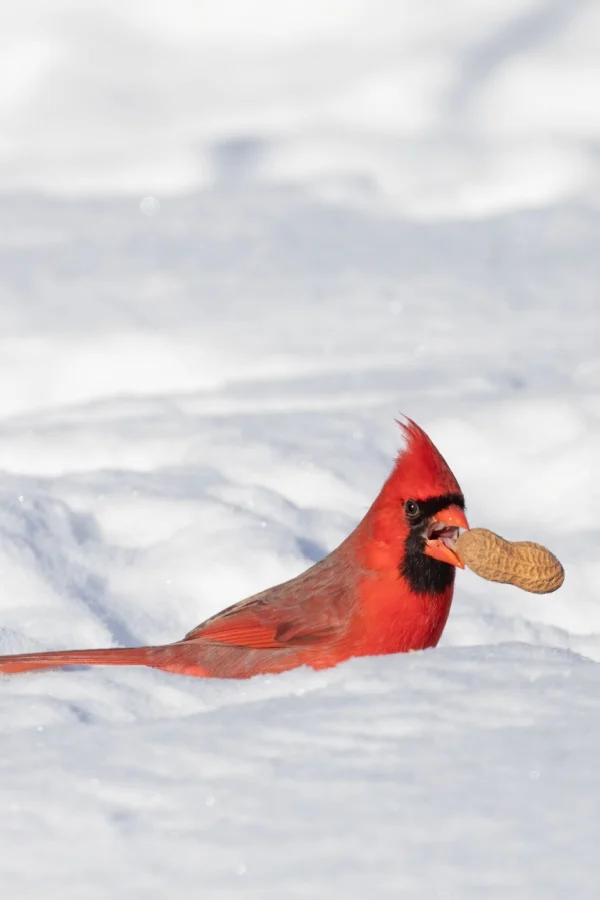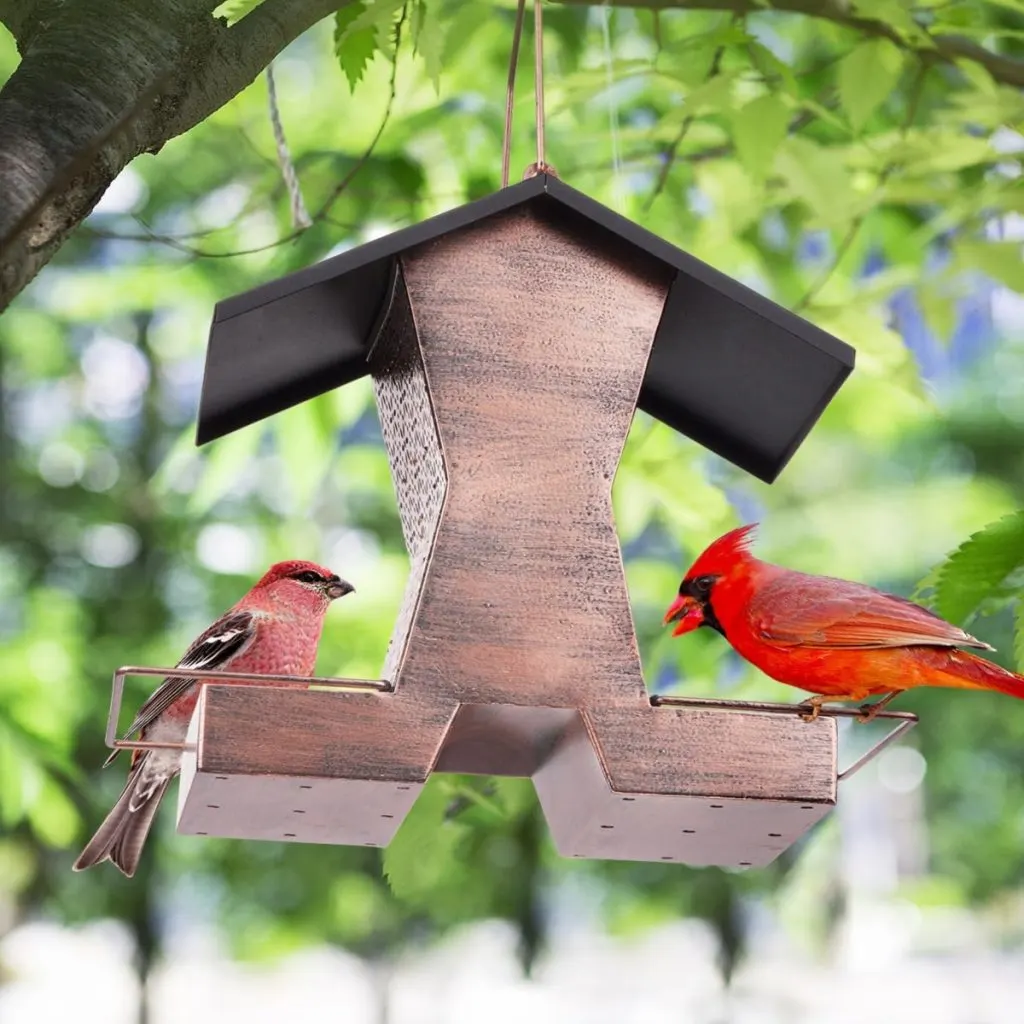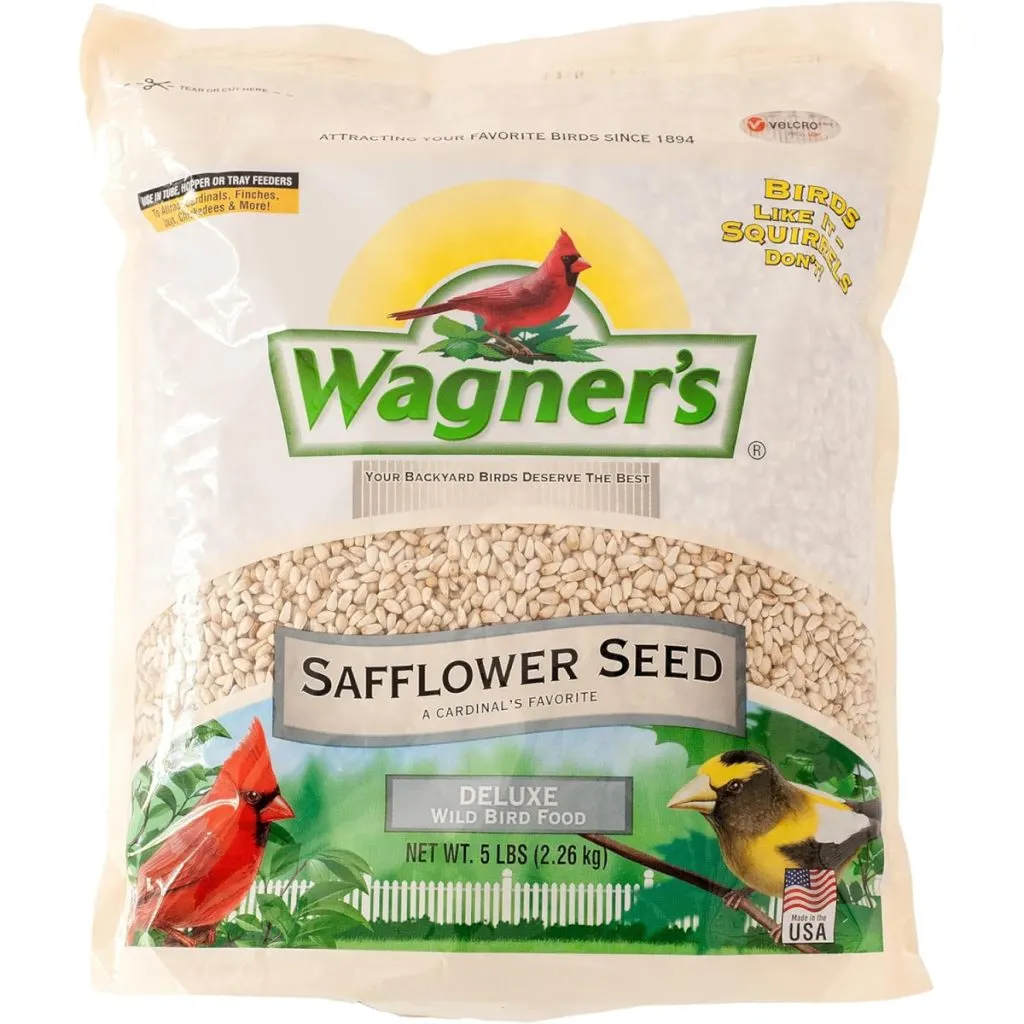Feeding cardinals in the winter months is not only one of the best ways to fill your landscape with gorgeous color and activity – but also to help these wondrous birds survive what can be a tough few months of their life!
There is little doubt that cardinals are one of the most colorful birds to see flying about the winter landscape. With the male’s vibrant crimson coloring and the female’s muted red feathering, they are definitely a welcoming sight of brightness in an otherwise bleak landscape.
Unlike most songbird species, cardinals do not migrate south during the winter. Instead, they seek shelter in shrubs and evergreen trees, feeding on nuts, weed seeds and wild berries. Unfortunately, many of those food sources become a bit difficult to forage in the colder months. Which is exactly why feeding them can play a huge role in helping them to survive!

Cardinals burn a lot of energy while they forage for food during the day. But during the winter, they need even more calories to help them stay warm and alive when the temperatures drop – especially during the overnight hours.
Without many options for natural food sources, the songbirds can run into big trouble during the winter months. But by helping to provide them with their favorite high-calorie foods, you can enjoy watching them from the comfort of your home – all while helping to keep them alive and thriving.
Feeding Cardinals In The Winter – How To Attract Redbirds!
While most birdseed mixes might attract a few cardinals here and there to your feeder, there are a few seeds and feeds that almost ensure big cardinal activity. In fact, if the feeding options are to their liking, it’s not uncommon to see a dozen or more cardinals around a single feeder!
The key to successfully feeding cardinals all revolves around supplying them with seeds that both the males and females enjoy – and that give them big energy. This will not only help cardinals survive, but actually thrive throughout the entire winter season by providing them with plenty of the calories they need.
The Two Most Important Times For Feeding Cardinals In The Winter
Although you may see cardinals all throughout the day at your feeders, there are two times that are particularly important for them to have food on hand – and those two times are early in the morning – and right before sunset.
The morning feeding allows the birds to replace all the energy they used up overnight. And feeding right before sunset? That allows the cardinals to build up calories to keep them warm when the temperatures fall overnight. With that in mind, it’s important to always try to make sure your feeders are full at these two critical times.
As for what type of feeder cardinals like best – it’s a platform feeder. These feeders work best for cardinals since they are front feeders, which is how cardinals prefer to eat. Affiliate Link: Metal Platform Bird Feeder
You can also use tube feeders as well as long as there is a place for the birds to land while enjoying a bite to eat. Whatever feeder you use, the big key is to keep it consistently full.
Cardinals will start to visit your feeder regularly as long as a good food source is provided. In addition, the birds will start to rely on the feed to help get them through the winter. The more they know it will be there, the more consistent their visits will be.
So now that we have covered feeding basics – let’s take a look at the foods cardinals love most. And at the top of the list – it’s black oil sunflower seeds!
Black Oil Sunflower Seeds – Feeding Cardinals In The Winter
Cardinals love all types of sunflower seeds. However, black oil sunflower seeds have a much higher oil content than striped sunflower seeds. And by adding black oil seeds to their mix, it results in a feed that is full of calories, nutrients and energy!
Listen In Below To Our Podcast On Feeding Birds In The Winter!
The high-fat seeds help to provide cardinals and other birds with the nutrition needed to stay nice and warm in the cold. Other birds like chickadees, finches, jays, nuthatches, and woodpeckers also enjoy snacking on black oil sunflower seeds.
The shells of black oil sunflower seeds are thinner and easier for even small birds to crack open than striped sunflower seeds. And, once they do open them, the birds are rewarded with large seeds, resulting in more food for their efforts. Affiliate Seed Link: Black Oil Sunflower Seeds
Safflower Seeds – Feeding Cardinals In The Winter
Another popular choice for feeding cardinals in the winder is safflower seeds. Safflower is a thistle-like annual that is commonly harvested commercially for vegetable oil. However, the 15 to 20 seeds you get per bloom are also perfect for feeding to cardinals.
In general, safflower seeds are a little less messy than sunflower seeds, resulting in fewer shells left behind by the birds. In fact, the husks usually blow away or simply decompose after a bit of time.
Like sunflower seeds, safflower seeds are high in fiber, proteins and carbohydrates. They too help to provide plenty of calories and energy to hungry cardinals. Birds such as chickadees and doves also enjoy safflowers since they have larger beaks to break open the shells.
A great bonus for adding safflowers to your cardinal bird feed mix is that chipmunks and squirrels don’t typically enjoy the seeds. They will often move on to other food sources when safflower is served for dinner. Affiliate Seed Link: Wagner’s Safflower Seed Wild Bird Food
Suet Treats – Feeding Cardinals In The Winter
Suet is another great option for providing cardinals with high calories and fat during the winter months. So what is suet? Suet is basically fat that has been rendered down and formed into blocks or balls. Affiliate Product Link: Blue Seal High Energy Suet Cakes
Often combined with seeds, fruit, and nuts, it’s a nutritionally dense food source that is perfect for hungry birds. The high-fat content of suet is great for heating the birds up and keeping them alive during frigid nights.
You can create your own homemade suet blocks or you can purchase pre-made blocks from stores or online. Making your own is a great way to control what items are added to help specifically attract cardinals. See our article: How To Make Bird Suet – The Perfect Recipe To Feed Birds In The Winter!
Shelled Whole Or Crushed Peanuts – Feeding Cardinals In The Winter
In addition to sunflowers, safflowers and suet, cardinals also enjoy consuming peanuts. Peanuts are another high-fat food that can be critical for keeping cardinals warm and well-fed during the winter months. In addition to fats, peanuts also provide cardinals with fiber, calcium, potassium, and other vital nutrients.

While larger birds like bluejays and woodpeckers enjoy peanuts in the shell, it’s best to provide cardinals with shelled peanuts. The peanuts can be whole or crushed. Just ensure that you use raw peanuts that have not been roasted, salted, or flavored in any way.
A Few More Favorites – Feeding Cardinals In The Winter
You can even occasionally provide cardinals with a tasty treat of all-natural peanut butter as a great alternative. Coating pine cones in peanut butter can be a fun winter activity for families to make with their kids.
A few other great options for feeding cardinals include cracked corn and dried berries. Cracked corn is high in protein and dried berries provide cardinals with an excellent source of nutrients.
One thing is for sure, by providing high-calorie foods to cardinals, you can enjoy watching these colorful birds visit your property all winter long – and help them survive the cold in the process! For more tips on feeding birds in the winter, check out our article: 3 Easy Ways To Feed Birds In The Winter – Without A Bird Feeder!
Simple Garden Life
Follow Our Facebook Page For Even More Great Tips! Simple Garden Life Facebook Page
Simple Garden Life is a website dedicated to keeping gardening fun, simple and enjoyable! We publish two new articles each week along with a new garden podcast episode every two weeks. This article may contain affiliate links.


